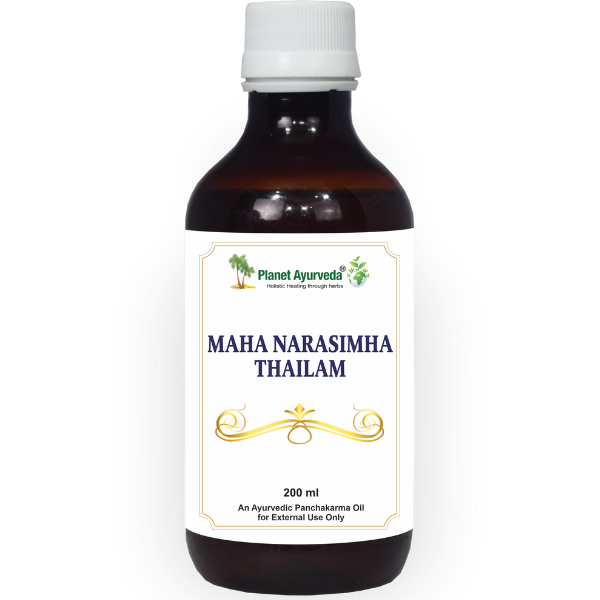Maha Narasimha Thailam – Key Ingredients, Their Benefits, Indications & Panchakarma Uses
Introduction
Maha Narasimha Thailam is a traditional Ayurvedic oil that has been trusted for generations to keep the body strong and healthy. It is inspired by the classical Ayurvedic oil Maha Narayana Thailam, carrying forward its nourishing and rejuvenating qualities in a refined form. This oil is known for giving energy, reducing tiredness, and helping the body feel relaxed and refreshed. When used for massage, it works deeply to ease stiffness, support flexibility, and calm the nerves. It is also widely used in Ayurvedic treatments to improve overall strength and restore balance in the body. Regular application of this oil not only soothes the muscles and joints but also brings a sense of relaxation to the mind. In this way, Maha Narasimha Thailam acts as a complete body rejuvenator that supports both physical and mental well-being.
Key Ingredients And Their Benefits
1. Bilva (Aegle marmelos) – Root/Stem, Bark
This herb contains coumarins, alkaloids, and flavonoids, which provide anti-inflammatory and analgesic actions. These compounds help relieve joint stiffness, improve circulation, and balance Vata in muscles and nerves.
2. Ashwagandha (Withania somnifera) – Root & Whole Plant
Rich in withanolides and alkaloids, it imparts analgesic, anti-inflammatory, and rejuvenating effects. They reduce muscle fatigue, strengthen nerves, and ease joint pain.
3. Gokshura (Tribulus terrestris) – Whole Plant
The saponins and flavonoids present in this plant improve circulation, relieve stiffness, and support musculoskeletal health. Their action helps balance Vata in joints and ligaments.
4. Shyonak (Oroxylum indicum) – Root/Stem, Bark
This herb contains flavonoids and baicalein, providing anti-inflammatory and analgesic actions. These compounds help reduce swelling, stiffness, and nerve discomfort.
5. Bala (Sida cordifolia) – Whole Plant
Its ephedrine alkaloids and fatty acids impart analgesic, anti-inflammatory, and muscle-strengthening actions, helping relieve pain and balance Vata in nerves and joints.
6. Paribhadra (Erythrina variegata) – Root
Contains flavonoids that provide anti-inflammatory and analgesic effects. They help relieve muscular tension, stiffness, and nerve discomfort.
7. Atibala (Abutilon indicum) – Whole Plant
Polysaccharides and flavonoids in this herb impart anti-inflammatory and Vata-balancing actions. These compounds soothe muscles, joints, and nerves.
8. Agnimantha (Clerodendrum phlomidis) – Root/Stem, Bark
Its phenolic compounds and flavonoids provide anti-inflammatory, analgesic, and circulation-enhancing effects, helping reduce joint pain and nerve stiffness.
9. Prasarini (Paederia foetida) – Whole Plant
Contains alkaloids and flavonoids, imparting anti-inflammatory and mild analgesic actions. Their effects help relieve muscular tension and stiffness.
10. Patla (Stereospermum suaveolens) – Root/Stem, Bark
Rich in flavonoids and essential oils, this herb provides anti-inflammatory and analgesic benefits, helping reduce stiffness and support nerve health.
11. Til Taila (Sesamum indicum) – Oil
It contains essential fatty acids, antioxidants, and vitamin E, providing nourishing, anti-inflammatory, and lubricating actions. These properties improve circulation, reduce stiffness, and balance Vata in muscles and joints.
12. Go Dugdha (Cow Milk) or Aja Dugdha / Caprae Lac (Goat Milk)
Go Dugdha (Cow Milk) or Aja Dugdha / Caprae Lac (Goat Milk) are key ingredients in Ayurvedic oils like Mahanarsimha Thailam, primarily used to balance Vata and Pitta doshas. Both are rich in proteins, vitamins, and minerals, it provides nourishing and rejuvenating effects. Its nutrients strengthen muscles, improve tissue elasticity, and support joint health.
13. Shatavari (Asparagus racemosus) – Root Tuber
Contains saponins and antioxidants, imparting anti-inflammatory, analgesic, and nervine tonic effects. They support muscle and joint health and reduce Vata-related discomfort.
14. Rasna (Pluchea lanceolata) – Root, Leaf
Rich in flavonoids, it provides analgesic and anti-inflammatory actions, helping reduce joint and muscle pain and stiffness.
15. Misreya (Foeniculum vulgare) – Fruit
Its essential oils and flavonoids impart anti-inflammatory and circulation-enhancing actions, helping soothe muscles and nerves.
16. Devdaru (Cedrus deodara) – Heart Wood
Contains lignans and essential oils that provide anti-inflammatory and analgesic effects, helping relieve joint and muscle stiffness.
17. Shalparni (Desmodium gangeticum) – Whole Plant
Rich in flavonoids, this herb imparts analgesic and anti-inflammatory actions, helping reduce stiffness and nourish muscles and nerves.
18. Prishnaparni (Desmodium gangeticum) – Whole Plant
Its flavonoids provide anti-inflammatory and circulation-enhancing effects, helping relieve muscular and nerve tension.
19. Mudgaparni (Desmodium gangeticum) – Heart Wood
Contains phenolics, imparting analgesic and anti-inflammatory actions. These help reduce joint pain and stiffness.
20. Masaparni (Teramnus labialis) – Whole Plant
Rich in flavonoids and glycosides, it provides anti-inflammatory and nerve-soothing effects, helping relieve muscle tension and pain.
21. Nagkesar (Mesua ferrea) – Stamens
Contains coumarins and essential oils, imparting anti-inflammatory and analgesic actions. These compounds help reduce swelling and joint pain.
22. Saindhav Lavana (Rock Salt) – Salt
Provides minerals and electrolytes, helping improve circulation, reduce stiffness, and balance Vata in joints and nerves.
23. Haridra (Curcuma longa) – Rhizome
Rich in curcuminoids, it imparts strong anti-inflammatory, analgesic, and antioxidant actions, helping reduce pain, stiffness, and swelling.
24. Daru Haridra (Berberis aristata) – Stem
Its berberine content provides anti-inflammatory and analgesic effects, improving circulation and reducing joint discomfort.
25. Shaileya (Parmelia perlata) – Whole Plant
Contains phenolics, imparting anti-inflammatory and analgesic actions. These help reduce muscular and joint pain.
26. Ela (Elettaria cardamomum) – Seed
Its essential oils provide circulation-enhancing and mild analgesic actions, helping relieve stiffness in muscles and nerves.
27. Manjishtha (Rubia cordifolia) – Root
Contains sesquiterpenes, imparting anti-inflammatory and nervine tonic effects, helping soothe muscles, nerves, and joints.
28. Yashti (Glycyrrhiza glabra) – Root
Its glycyrrhizin content provides anti-inflammatory and analgesic effects, nourishing tissues and reducing Vata imbalance.
29. Tagara (Valeriana wallichii) – Root/Rhizome
Contains valepotriates, imparting nervine tonic and muscle-relaxing actions, helping reduce stiffness, spasms, and nerve discomfort.
30. Musta (Cyperus rotundus) – Rhizome
Rich in essential oils, it provides anti-inflammatory and analgesic effects, helping relieve muscular and joint pain.
31. Tejpatra (Cinnamomum tamala) – Leaf
Contains cinnamaldehyde, providing circulation-enhancing and analgesic actions, helping reduce stiffness and swelling.
32. Tvak (Cinnamomum zeylanicum) – Stem/Bark
Rich in cinnamaldehyde, it imparts anti-inflammatory, analgesic, and circulation-enhancing effects, helping relieve joint stiffness.
33. Jivaka (Microstylis wallichii) – Root Tuber
Contains glycosides and flavonoids, providing anti-inflammatory and analgesic actions, helping reduce stiffness and pain in joints and muscles.
34. Rishabhaka (Malaxis muscifera) – Root Tuber
Its phenolics provide analgesic and anti-inflammatory effects, supporting nerve and muscle health.
35. Meda (Polygonatum verticillatum) – Root Tuber
Rich in saponins, it imparts anti-inflammatory and Vata-balancing actions, helping reduce stiffness and nourish muscles.
36. Maha Meda (Polygonatum cirrhifolium) – Root Tuber
Contains saponins and polysaccharides, providing analgesic and nerve-strengthening actions, helping relieve joint and muscle discomfort.
37. Kakoli (Roscoea purpurea) – Root
Its flavonoids impart anti-inflammatory and analgesic effects, supporting musculoskeletal health.
38. Kshir Kakoli (Lilium polyphyllum) – Root
Rich in glycosides, it provides nourishing, analgesic, and anti-inflammatory actions, helping relieve Vata-related stiffness.
39. Riddhi (Herminium edgeworthii) – Root Tuber
Contains phenolics, providing analgesic and circulation-enhancing effects, helping reduce joint and muscle pain.
40. Vriddhi (Habenaria intermedia) – Root Tuber
Its flavonoids provide anti-inflammatory, analgesic, and Vata-balancing actions, helping relieve stiffness and nerve discomfort.
41. Hrivira (Pavonia odorata) – Root
Contains flavonoids and glycosides, imparting anti-inflammatory and analgesic effects, helping soothe muscles and nerves.
42. Vacha (Acorus calamus) – Rhizome
Rich in essential oils and phenolics, it provides nervine tonic, anti-inflammatory, and analgesic actions, helping relieve stiffness and pain.
43. Palash (Butea monosperma) – Stem, Bark
Its flavonoids impart analgesic and anti-inflammatory effects, helping reduce joint and nerve stiffness.
44. Sthauneya (Taxus baccata) – Whole Plant
Contains alkaloids and glycosides, providing analgesic and anti-inflammatory actions, helping strengthen nerves and muscles.
45. Choraka (Angelica glauca) – Rhizome
Rich in essential oils and coumarins, it imparts circulation-enhancing, analgesic, and anti-inflammatory effects, helping relieve stiffness.
46. Karpura (Cinnamomum camphora) – Sublimated Extract
Contains camphor, providing cooling, analgesic, and anti-inflammatory actions, helping relieve nerve pain and stiffness.
47. Kesar (Crocus sativus) – Style/Stigma
Its crocin and safranal impart antioxidant, anti-inflammatory, and tissue-nourishing effects, helping reduce joint and muscle discomfort.
Benefits of Maha Narsimha Thailam
This oil provides following benefits:
- Vata-Pacifying (Vata Shamak) – Balances aggravated Vata, which is responsible for pain, stiffness, and nervous system disorders.
- Anti-inflammatory (Shothahara) – Reduces swelling and inflammation in joints, muscles, and tissues.
- Analgesic (Vedanasthapana) – Relieves pain in joints, muscles, and nerves.
- Muscle Relaxant (Sankocha Nashaka) – Reduces cramps, spasms, and tension in muscles.
- Strengthening (Balya) – Nourishes muscles, bones, and connective tissues, enhancing overall strength.
- Rejuvenative (Rasayana) – Promotes tissue regeneration and overall vitality.
- Warming (Usna Virya) – Generates warmth in the body, improving blood circulation and easing stiffness.
- Lubricating (Snigdha) – Helps in smooth joint movement and reduces friction in tissues.
- Detoxifying (Ama Pachana) – Helps break down toxins (Ama) in muscles and joints, supporting healing.
Indications of Maha Narsimha Thailam
The therapeutic indications of Maha Narsimha Thailam are wide-ranging, particularly for conditions caused by Vata imbalance. Here are the key uses:
- Joint Disorders: It is highly effective in managing arthritis, osteoarthritis, and other joint problems. It reduces pain, swelling, and stiffness, improving joint mobility.
- Muscle Pain and Spasms: The oil soothes sore muscles and eases cramps or spasms. Regular massage helps muscles relax and recover from strain or fatigue.
- Nerve-Related Problems: It supports nerve health and helps relieve tingling, numbness, sciatica, and radiating pain. The oil pacifies Vata, which often causes nerve discomfort.
- Back Pain: For lower back pain and stiffness, this oil provides relief and supports healthy spinal function. It is especially useful in Vata-related back disorders.
- Post-Injury Care: The oil aids recovery from minor sprains, strains, or injuries. It reduces inflammation and promotes healing of the affected area.
- Degenerative Conditions: In conditions like spondylosis or other degenerative musculoskeletal disorders, the oil helps slow tissue degeneration and maintain structural strength.
- General Weakness or Stiffness: It strengthens muscles, bones, and connective tissues, making the body more resilient and flexible.
- Vata Imbalance: It balances aggravated Vata, supporting overall musculoskeletal and nervous system health.
Panchakarma Use of Maha Narsimha Thailam
Maha Narasimha Thailam is widely used in Panchakarma therapies to manage Vata-related disorders (mentioned above). It is primarily applied during Abhyanga (therapeutic oil massage) and Swedana (Sudation Therapy).
To buy Maha Narsimha Thailam, please visit store.planetayurveda.com/products/maha-narasimha-thailam
Conclusion
Maha Narasimha Thailam is a classical Ayurvedic oil that offers comprehensive support for the body and mind. Its carefully selected herbs and nourishing ingredients work synergistically to relieve pain, reduce stiffness, strengthen muscles and joints, and restore balance in Vata-related disorders. Regular application, whether through daily massage or Panchakarma therapies like Abhyanga and Swedana, promotes flexibility, enhances circulation, soothes nerves, and improves overall vitality. By combining therapeutic, rejuvenative, and nourishing properties, Maha Narasimha Thailam serves as a complete body tonic, supporting both physical and mental well-being.




